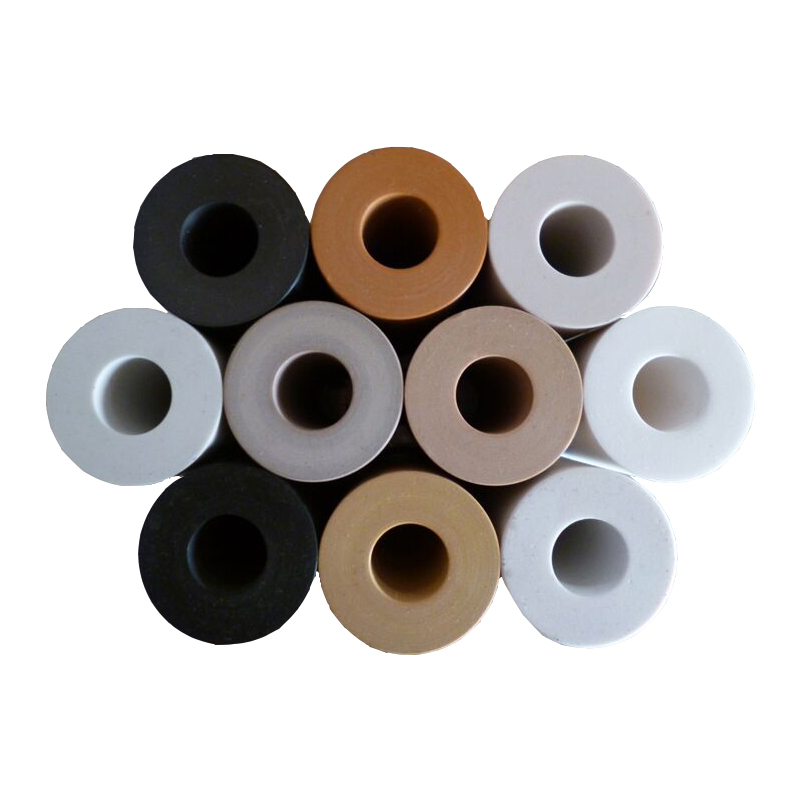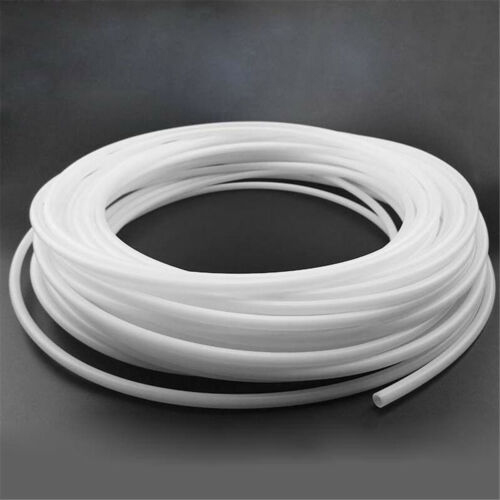What is PTFE?
PTFE stands for Polytetrafluoroethylene. It is a special high-performance plastic composed of fluorine and carbon atoms, which is a type of polymer. PTFE is a transparent, insulating, chemically inert, and non-toxic material with unparalleled chemical resistance, hardly reacting with any medium.

|
Characteristics |
Description |
|
Non-stick |
Surface is highly non-stick, substances hardly adhere to it |
|
High Temperature Resistance |
Can withstand extended periods at high temperatures, up to 260°C (500°F) |
|
Chemical Corrosion Resistance |
Excellent resistance to chemical corrosion, unaffected by acids, alkalis, organic solvents, etc. |
|
Insulation |
Excellent insulating material, suitable for electrical and electronic applications |
|
Low Friction Coefficient |
Extremely low surface friction coefficient, ideal as a lubricating material |
|
Good Aging Resistance |
Resistant to factors like light, heat, oxidation, and weather, with good durability |
|
Excellent Mechanical Properties |
High elastic modulus and tensile strength, a robust and durable engineering plastic |
|
Food-Grade Safety Certification |
Safe for food and beverage contact, complying with food-grade safety standards |
|
Ultra-Low Temperature Performance |
Maintains strength and durability under extremely low-temperature conditions |
|
Stability |
Exhibits excellent chemical stability, resistant to decomposition and deterioration |
|
Lightweight |
Low density, ideal for lightweight designs and applications |
|
Transparency |
Transparent, suitable for applications with special transparency requirements |
Key Points for Purchasing PTFE Tubes from China:
1.Supplier Selection:
Choose reputable and experienced PTFE tube suppliers. You can refer to industry reputation, exchange experiences with other buyers, or directly communicate with suppliers to understand their reliability and product quality.
2.Quality Certification:
Ensure that the PTFE tubes provided by the supplier meet international standards or relevant certification standards in your country. Request product quality certifications or test reports to ensure compliance with your requirements.
3.Product Specifications:
Clearly specify the technical requirements for the PTFE tubes you need, such as size, dimensions, thickness, etc., and confirm whether the products meet your requirements with the supplier.
4.Quotation and Price:
Compare quotations and price structures from multiple suppliers. Also, consider factors such as transportation costs and tariffs to ensure a competitive final price.
5.Delivery Time:
Understand the supplier's delivery time to ensure timely receipt of the required products.
6.Quality Sampling:
Before collaborating with the supplier, you can request quality sampling tests to verify product quality compliance.
7.Contract Terms:
Sign clear contract terms to ensure the rights and obligations of both parties, including product quality, delivery time, payment methods, etc.
8.Understand Import Requirements:
Understand the import regulations and requirements for PTFE tubes in your country, including labeling requirements, certification documents, etc., to ensure compliance with local regulations.
9.After-Sales Service:
Understand the supplier's after-sales service policies to ensure timely technical support and problem-solving assistance when needed.
Logistics and Transportation:
Choose a reliable logistics company to ensure safe and efficient transportation of the products to your destination.
How to ensure quality in advance?
YOZONETECH will provide accurate sizes and sufficient quantities of free samples according to customer requirements to ensure the reliability of test results. We have a large inventory to ensure the delivery of samples or finished products.
Applications of PTFE Tubes:
1.Chemical Industry:
PTFE tubes are widely used in the chemical industry for the transportation and handling of various corrosive chemicals. Due to its excellent corrosion resistance, it can be used for the transmission of concentrated acids, alkalis, organic solvents, and other strong corrosive substances.
2.Medical Field:
PTFE tubes have multiple uses in medical devices, including drug delivery and as catheters for cardiovascular interventions. Its non-stick property prevents drugs from adhering to the inner walls of the tube and also reduces the interaction with body fluids.
3.Food Industry:
PTFE tubes can be used for the transportation of food and beverages, especially in places with high sanitary standards. Due to its non-stick and high-temperature resistance properties, it is an ideal material for food contact.
4.Automotive Industry:
PTFE tubes are used in automotive manufacturing for making hydraulic lines, fuel lines, and gas transfer lines, among others. Its oil and high-temperature resistance make it widely used in engines and hydraulic systems.
5.Aerospace:
Due to its lightweight, high-temperature stability, and excellent chemical corrosion resistance, PTFE tubes are used in aerospace for hydraulic systems, sensor cables, and other critical components.
6.Electrical and Electronics:
PTFE tubes are used as insulating sheathing to protect wires and cables, especially in high-temperature and chemically corrosive environments.
7.Laboratory Applications:
PTFE tubes are commonly used as transfer pipelines for chemical reagents, solvents, and gases in laboratories. PTFE is an ideal alternative to glass due to its inertness and durability.

Types and Related Applications of PTFE Tubes
|
PTFE Tube Size |
Applications |
|
Small Diameter PTFE Tube (Inner Diameter < 1mm) |
1. Medical devices, such as catheters and infusion tubes |
|
|
2. Small-scale gas or liquid transfer pipelines, such as microfluidic systems |
|
|
3. Laboratory instruments, such as chromatography columns and reagent tubes |
|
|
4. Small electronic component encapsulation |
|
|
5. Microfluidic control devices |
|
Medium Diameter PTFE Tube (Inner Diameter 1mm - 20mm) |
1. High-temperature liquid transfer pipelines, such as in chemical reaction equipment |
|
|
2. Automotive fuel lines, brake fluid lines, etc. |
|
|
3. Insulating sheathing for electrical and electronic applications |
|
|
4. Medical applications, such as infusion tubes and catheters |
|
|
5. Transfer pipelines for laboratory reagents or samples |
|
Large Diameter PTFE Tube (Inner Diameter > 20mm) |
1. Large flow liquid transfer pipelines in chemical plants |
|
|
2. Lining material for large-scale chemical reaction vessels |
|
|
3. High-temperature gas transfer pipelines, such as high-temperature gas delivery |
|
|
4. High-pressure liquid transfer pipelines, such as high-pressure liquid delivery |
|
|
5. Energy-related pipelines, such as oil and gas pipelines |
PTFE Tube - Processing Techniques
Because polytetrafluoroethylene (PTFE) is a complex polymer material with unique properties such as high melting point, high elastic modulus, and non-stick characteristics, the processing techniques require special attention. Here are several common processing techniques:
1.Cutting:
PTFE tubes can be cut using cutting tools such as cutting knives or wire cutters. During the cutting process, it is essential to ensure smooth edges to avoid irregularities or burrs.
2.Hot Fusion Welding:
Hot fusion welding of PTFE tubes involves melting and fusing two tube sections together using heat. This requires special heating tools and precise control of the melting temperature.
3.Compression Molding:
PTFE powder is heated to its melting point and then compressed to achieve the desired tube shape.
4.Expansion Processing:
The PTFE tube is heated to a high temperature using special expansion tools and then expanded to the desired size using an expansion head.
5.Wrapping:
PTFE tubes can be manufactured by wrapping PTFE tape or PTFE sheets around a mold and then pressing it to form the tube shape.
6.Wire Reinforcement:
In specific applications, PTFE tubes can be reinforced with wire winding to increase their mechanical strength.
7.Surface Treatment:
Due to the non-stick property of PTFE, surface treatment is essential. Oxidation, roughening, or other methods are typically used to enable adhesion or coating with other materials.
☛ Learn More
Yozonetech FEP, PFA and PTFE tube Website ➤ https://www.chinaptfetube.com/
Facebook ➤ https://www.facebook.com/ChinaFEPtube
LinkedIn ➤ https://www.linkedin.com/company/chinaptfetube/
YouTube ➤ https://www.youtube.com/channel/UCWzNjAgghr0B7tXDrP_jwfA
--------------------------------------------------------------------------
☛ Enquiry Service:
Email : [email protected]
WhatsApp: wa.me/008613752771911